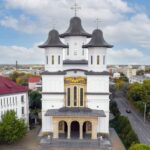
“Ascension of Jesus” and “Three Holy Hierarchs” Archdiocesan Cathedral Church
December 30, 2022
“Chesarie the Bishop” old seminary
December 30, 2022English
THE BISHOP'S PALACE
The archbishop's palace was built in the time of ruler of Wallachia, Matei Basarab (1632-1654). In its current form it is dated 1844, having been rebuilt by Bishop Chesarie on the place of the one built by Matei Basarab and rebuilt by Constantin Brâncoveanu (1688-1714), in the form of a building with a cellar, with eight hemispherical calottes lying on large brick arches resting on the side walls and on the three massive pillars in the centre. In 1691, through the efforts of Bishop Mitrofan (1691-1702), Constantin Brâncoveanu established a printing house in the Bishop's cells, where for over two centuries numerous valuable books on church service and teaching were printed. The first book printed was "Pravoslavnica mărturisire" ["Orthodox confession"], written by Petru Movilă, Metropolitan of Kiev, approved by the Synod of Iași in 1642, translated from Greek into Romanian by Radu Greceanu, assisted by high steward Constantin Cantacuzino. The room where ruler Alexandru Ioan Cuza stayed for one night on 5th/6th February 1859, while passing from Iași to Bucharest, is located in this building. The current palace was built over this cellar in the style of Brâncoveanu, which was transformed, following restoration works between 1982-1986, into a large reception hall, according to the plans of Bishop Antonie Plămădeală. The small gazebo in the style of Brâncoveanu on the eastern side of the palace was also restored during that period. Bishop's Palace of Buzău is the residence of the local hierarch and it is included in the List of Historical Monuments (BZ-II-m-A-02324.03).




